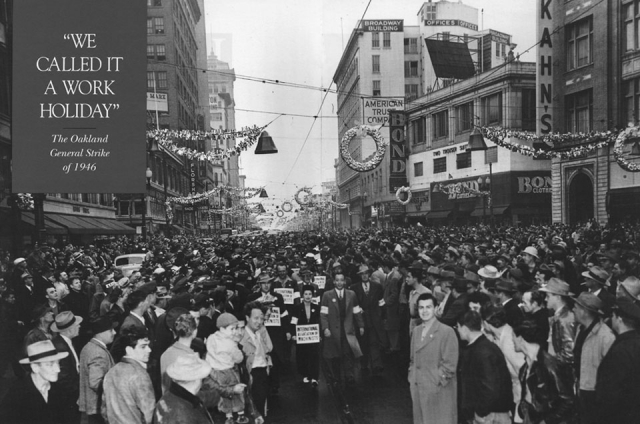The 1946 Oakland General Strike

December of 1946, Oakland was the location of the sixth general strike of that year and the last general strike in the United States. The strike began when two downtown retail stores and the local police, attempted to break up a strike being held by department workers.
The strike began in late October as women and men at two department stores, Hastings and Kahn's, demanded the right to unionize their workplaces. Local Teamsters unions immediately supported the strike and refused to deliver new good to the stores. Elevator repair union members refused to fix an out of service elevator and union painters working at the stores walked off the job. Local labor councils, the NAACP and the National Negro Congress urged a boycott of both stores. In response, the employer association ran a massive campaign in the newspapers demonizing the striking workers. The newspaper editorials demanded that the city government ban picketing.
The department stores brought in local scab labor to continue to work in the stores while the pickets were going on. During the end of November one of these scabs punched a striking woman in the face. In response a mass rally to support the strikers, most of whom were women, was called for December 3rd. Discussions of a general work stoppage began.
Since the busy Christmas shopping season was nearing, the department store owners were becoming more desperate to get goods into the stores. After a meeting which included owners of local newspapers, bank owners, the chief of police and the district attorney it was decided to bring in professional strikebreakers from Los Angeles to deliver goods to the stores.
Strike supporters got word of this plan and beefed up picket lines, preparing to stop any scabs from making a delivery. The morning of December 3rd there were hundreds of strikers and supporters picketing the two department stores. Over 300 police showed up to clear way for the scabs. Police shoved union members out of the area and built barricades through downtown, allowing the delivery trucks to pass through.
A streetcar was stopped by the police barricades. The angry driver abandoned his streetcar in the middle of the road and soon asked his fellow drivers to do the same. They formed a solidarity picket and the general strike unofficially began. People who took street cars to work were unable to get past the commotion. Downtown Oakland soon filled with stranded workers, who began to organize themselves in the middle of the streets. Soon a festive "work holiday" was in effect and the center of the city was controlled by the workers.
The city shut down, "flying squads" were sent out to prevent strikebreaking, jukeboxes playing music filled the streets and more than 100,000 people, a quarter of the city's population went on strike. The crowds at Telegraph Avenue and Broadway ranged from 10,000 to 30,000. Stan Weir remembers one incident of the strike:
Some Army recruiting truck came in town through that mass of strikers and the lieutenant on that truck said over a P. A. system, 'Why aren't you all out fightin' for your country instead of striking?' Most of the bus drivers still had their Eisenhower jackets with the hash marks on because they could use their Army uniform as part of their bus driver's uniform. And some big ex-top sergeant said, 'Where do you think we got these?' With that he sang out, 'Fall in!' and about a hundred men lined up and he put them through close order drill. Pretty soon there were several hundred going through this close order drill. They marched on City Hall and demanded to see the mayor. He wasn't in, of course.
The capitalist media played a huge role in suppressing the 1934 San Francisco general strike and the Oakland workers knew this. One of the first things that Oakland strikers did was to send out pickets to all the local newspapers and shut them down. Teamsters did their part by refusing to deliver any form of outside capitalist media into Oakland. The only media allowed into Oakland was that created by the strikers. When the capitalists realized they had no way to demoralize and undermine the strike they went to the union leadership.
When union leadership finally did get involved with the general strike it was to quickly make a deal with the city and to urge workers to get back to their jobs and to focus their energies on electoral politics. This resulted in the election of four out of five labor-friendly city council members.The striking department store workers got no help from the union leadership and most rank-and-file workers saw this as a squandered opportunity. Not long after this last general strike the United States congress passed the anti-labor Taft-Hartley Act, which amongst many other provisions made sympathy or jurisdictional strikes illegal. In effect the general strike became illegal and the United States has not seen one since 1946.
The main piece of evidence of the Oakland general strike is a small plaque put up by the Alameda Labor Council ALF-CIO on the side of a building off of Broadway and 15th street. Though streetcars no longer operate in Oakland, and many of the stores have changed their names, most of the same buildings that witnessed the last general strike of the US still stand today. Walking through downtown one can imagine what this massive "work holiday" must have looked and felt like.